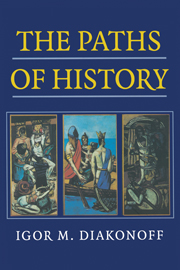Book contents
- Frontmatter
- Contents
- Foreword by Geoffrey Hoskins
- Preface
- Introduction
- 1 First Phase (Primitive)
- 2 Second Phase (Primitive Communal)
- 3 Third Phase (Early Antiquity)
- 4 Fourth Phase (Imperial Antiquity)
- 5 Fifth Phase (the Middle Ages)
- 6 Sixth Phase (the Stable Absolutist Post-Medieval Phase)
- 7 Seventh Phase (Capitalist)
- 8 Eighth Phase (Post-Capitalist)
- Index
2 - Second Phase (Primitive Communal)
Published online by Cambridge University Press: 02 December 2009
- Frontmatter
- Contents
- Foreword by Geoffrey Hoskins
- Preface
- Introduction
- 1 First Phase (Primitive)
- 2 Second Phase (Primitive Communal)
- 3 Third Phase (Early Antiquity)
- 4 Fourth Phase (Imperial Antiquity)
- 5 Fifth Phase (the Middle Ages)
- 6 Sixth Phase (the Stable Absolutist Post-Medieval Phase)
- 7 Seventh Phase (Capitalist)
- 8 Eighth Phase (Post-Capitalist)
- Index
Summary
The prehistory of civilisation first began in the Near East, where in the mountains surrounding the Fertile Crescent were found wild cereals, and animals comparatively easy to domesticate: sheep, ancestors of domestic cattle, pigs and donkeys. Here also existed soils suitable for artificial sowing. The conditions were most favourable for the development of production with all the ensuing circumstances. On the American continent, the inhabitants of the more favourable regions had at their disposal such domesticable plants as Indian corn, potatoes, tomatoes, peanuts and cocoa-beans, but their cultivation demanded technical developments; therefore, a level similar to that of Sumer or Pharaonic Egypt was reached by the local population about 4,000 years later – a minor time span compared to the entire history of mankind.
According to the formerly accepted Marxist theoretical periodisation, until the beginning of ‘class civilisation’ (i.e. mainly in the dry subtropical zone), the whole territory inhabited by mankind was dominated by a ‘primitive communal’ mode of production.
A mode of production, by definition, depends on the type of property relations, on the type of the combination of labour power with the means of production, on the forms of connection between the producers, the class structure of the society and the motives and goals of economic activity. In the case of ‘primitive communal’ society, we should of course drop the class structure of the society from the definition. But even with this correction, we actually cannot assign all the ‘pre-class’(or ‘pre-urban’) societies to one and the same mode of production.
- Type
- Chapter
- Information
- The Paths of History , pp. 13 - 20Publisher: Cambridge University PressPrint publication year: 1999

